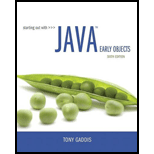
Gas Prices
In the student sample program files for this chapter, you will find a text file named GasPrices.txt. The file contains the weekly average prices for a gallon of gas in the United States, beginning on April 5, 1993, and ending on August 26, 2013. Here is an example of the first few lines of the file’s contents:
04-05-1993:1.068
04-12-1993:1.079
04-19-1993:1.079
4-26-1993:1.086
5-03-1993:1.086
and so on …
Each line in the file contains the average price for a gallon of gas on a specific date. Each line is formatted in the following way:
MM is the two-digit month, DD is the two-digit day, and YYYY is the four-digit year. Price is the average price per gallon of gas on the specified date.
For this assignment you are to write one or more programs that read the contents of the file and perform the following calculations:
Average Price Per Year: Calculate the average price of gas per year, for each year in the file. (The file’s data starts in April, 1993, and it ends in August, 2013. (For the years 1993 and 2013, use only the data that is present for those years.)
Average Price Per Month: Calculate the average price for each month in the file.
Highest and Lowest Prices Per Year: For each year in the file, determine the date and amount for the lowest price, and the highest price.
List of Prices, Lowest to Highest: Generate a text file that lists the dates and prices, sorted from the lowest price to the highest.
List of Prices, Highest to Lowest: Generate a text file that lists the dates and prices, sorted from the highest price to the lowest.
You can write one program to perform all of these calculations, or you can write different programs, one for each calculation.
Want to see the full answer?
Check out a sample textbook solution
Chapter 8 Solutions
Pearson eText for Starting Out with Java: Early Objects -- Instant Access (Pearson+)
Additional Engineering Textbook Solutions
Starting Out with Java: From Control Structures through Objects (7th Edition) (What's New in Computer Science)
Web Development and Design Foundations with HTML5 (8th Edition)
Mechanics of Materials (10th Edition)
Starting Out with C++: Early Objects (9th Edition)
INTERNATIONAL EDITION---Engineering Mechanics: Statics, 14th edition (SI unit)
Modern Database Management
- Do you think that computers should replace teachers? Give three references with your answer.arrow_forwardIs online learning or face to face learning better to teach students around the around the world? Give reasons for your answer and provide two references with your response. What are benefits of both online learning and face to face learning ? Give two references with your answer. How does online learning and face to face learning affects students around the world? Give two references with your answer.arrow_forwardExplain Five reasons if computers should replace teachers. Provide three references with your answer. List three advantages and three disadvantages face to face learning and online learning may have on children. Provide two references with your answer.arrow_forward
- You were requested to design IP addresses for the following network using the address block 10.10.10.0/24. Specify an address and net mask for each network and router interfacearrow_forwardFor the following network, propose routing tables in each of the routers R1 to R5arrow_forwardFor the following network, propose routing tables in each of the routers R1 to R5arrow_forward
- Using R language. Here is the information link. http://www.cnachtsheim-text.csom.umn.edu/Kutner/Chapter%20%206%20Data%20Sets/CH06PR18.txtarrow_forwardUsing R languagearrow_forwardHow can I type the Java OOP code by using JOptionPane with this following code below: public static void sellCruiseTicket(Cruise[] allCruises) { //Type the code here }arrow_forward
- Draw a system/level-0 diagram for this scenario: You are developing a new customer relationship management system for the BEC store, which rents out movies to customers. Customers will provide comments on new products, and request rental extensions and new products, each of which will be stored into the system and used by the manager for purchasing movies, extra copies, etc. Each month, one employee of BEC will select their favorite movie pick of that week, which will be stored in the system. The actual inventory information will be stored in the Entertainment Tracker system, and would be retrieved by this new system as and when necessary. Example of what a level-0 diagram looks like is attached.arrow_forwardWhat is the value of performing exploratory data analysis in designing data visualizations? What are some examples?arrow_forwardDraw a level-0 diagram for this scenario: You are developing a new customer relationship management system for the BEC store, which rents out movies to customers. Customers will provide comments on new products, and request rental extensions and new products, each of which will be stored into the system and used by the manager for purchasing movies, extra copies, etc. Each month, one employee of BEC will select their favorite movie pick of that week, which will be stored in the system. The actual inventory information will be stored in the Entertainment Tracker system, and would be retrieved by this new system as and when necessary.arrow_forward
 EBK JAVA PROGRAMMINGComputer ScienceISBN:9781337671385Author:FARRELLPublisher:CENGAGE LEARNING - CONSIGNMENT
EBK JAVA PROGRAMMINGComputer ScienceISBN:9781337671385Author:FARRELLPublisher:CENGAGE LEARNING - CONSIGNMENT EBK JAVA PROGRAMMINGComputer ScienceISBN:9781305480537Author:FARRELLPublisher:CENGAGE LEARNING - CONSIGNMENT
EBK JAVA PROGRAMMINGComputer ScienceISBN:9781305480537Author:FARRELLPublisher:CENGAGE LEARNING - CONSIGNMENT Programming with Microsoft Visual Basic 2017Computer ScienceISBN:9781337102124Author:Diane ZakPublisher:Cengage Learning
Programming with Microsoft Visual Basic 2017Computer ScienceISBN:9781337102124Author:Diane ZakPublisher:Cengage Learning Microsoft Visual C#Computer ScienceISBN:9781337102100Author:Joyce, Farrell.Publisher:Cengage Learning,Programming Logic & Design ComprehensiveComputer ScienceISBN:9781337669405Author:FARRELLPublisher:CengageNp Ms Office 365/Excel 2016 I NtermedComputer ScienceISBN:9781337508841Author:CareyPublisher:Cengage
Microsoft Visual C#Computer ScienceISBN:9781337102100Author:Joyce, Farrell.Publisher:Cengage Learning,Programming Logic & Design ComprehensiveComputer ScienceISBN:9781337669405Author:FARRELLPublisher:CengageNp Ms Office 365/Excel 2016 I NtermedComputer ScienceISBN:9781337508841Author:CareyPublisher:Cengage





